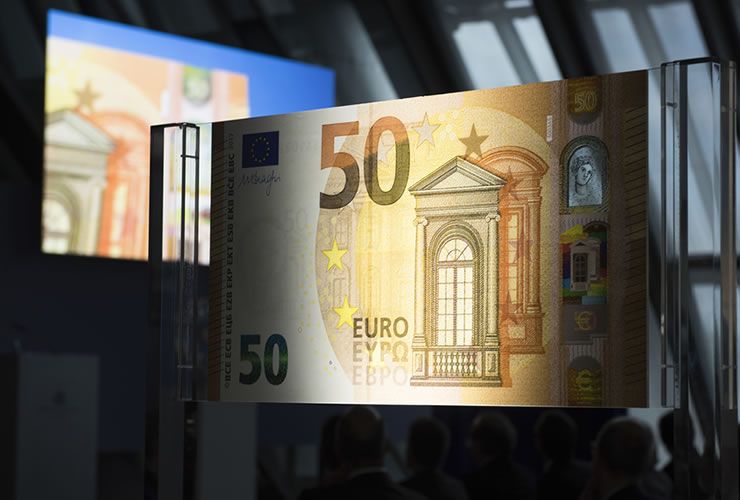EUR/USD (EUR/USD): Strategy from UBS, Danske Bank and Societe Generale
- Written by: Gary Howes
-
A number of leading institutional strategists tell us how to approach the EUR/USD exchange rate which has embarked on a journey back towards the top of its long-term range.
The Euro has come off its recent peak against the US Dollar as we move through the final trading session of a week that has gone well for the shared currency.
The EUR/USD has risen from 1.1162 to the current 1.1339, arguably more as a result of broad-based US Dollar weakness than anything else.
The latest bout of USD selling cam in the wake of the release of the all-important Federal Reserve minutes which shows policy makers remain as stubborn as ever to pushing up the cost of borrowing in the US.
The Dollar needs the promise of higher rates on the horizon to sustain its rally, until then we would expect the Euro to take advantage.
For now, it would appear the Fed is not willing to provide the fuel.
Can the gains be held and extended, or will the pair ultimately fall back into the sticky 1.11s again?
UBS: Dollar has Peaked
Strategists at UBS say they continue to expect a higher EUR/USD.
"We have long argued that the trade-weighted dollar has peaked against DM currencies, and we continue to forecast EUR/USD to grind higher to 1.16 by year end," says a note releasd by UBS, supplied to this author by eFXNews.
EUR/USD’s range during the past year has been among the narrowest since 2000, and UBS believe EUR/USD is likely to remain difficult to trade as central banks continue to lean against currency strength.
"Favourable valuation, and growth re-synchronization between the US and Euro area should continue to support the euro, pushing it higher. In addition to expecting a higher EUR/USD, we remain bullish EUR/CHF and EUR/SEK," say UBS.
Danske Bank Looking Higher
Danske Bank have also furnished their clients with reasons why they believe the Euro is aimed higher:
Growth.
US growth surprised on the downside in Q2 but recent labour market data has surprised on the upside. Private consumption should be supported in coming months despite the weak July retail sales.
European data have been stronger than analysts had expected given Brexit but the sharp slowdown in the UK is likely to impact the eurozone with a lag. As such, Danske expect to see some softness in European data in the coming months.
Monetary policy.
The Fed was slightly more hawkish than expected at its July meeting. Fed chairman Janet Yellen is likely to give more clarity on her thinking regarding monetary policy at her Jackson Hole speech on 26 August.
Danske Bank believe that the Fed will wait until H1 17 to raise interest rates again.
The market is pricing around 40% probability for a 25bp rate hike before end- 2016 which appears fair.
Meanwhile, we expect that the ECB as a minimum will have to extend its QE purchases beyond March 2017 but it is unlikely that it will cut interest rates further.
Flows.
The market is short EUR/USD according to IMM data but not in stretched territory. As such, this increases the sensitivity of the cross to any impetus from relative rates.
Valuation. Both our PPP and MEVA models suggest the mid- 1.20s are ‘fundamentally’ justified and thus that the cross remains undervalued.
Danske Bank’s forecasts for the EUR/USD pair are: 1.12 in one month, 1.12 in three months, 1.14 in six months and 1.18 in twelve months.
Soc Gen: 1.1460/1.15 Next Critical Hurdles
Meanwhile, analysts at Societe Generale have told clients that those trading the world’s largest currency pair should ensure they have wide limits.
In a note to clients, Soc Gen say:
"Having undergone a steady downtrend until last year, EUR/USD came up against crucial support at a multi decade channel limit which currently stands at 1.0820/1.0782.
"Since then a pause is under way and the pair has been witnessing a broad range bound-configuration.
"The upside has so far remained constricted by graphical levels of 1.1460/1.15 which has acted as resistance last May, October as well as in April this year.
"On the other hand, February low of 1.0820/1.0782 has acted as crucial support. Medium term, these form wide limits for EUR/USD."
According to Soc Gen's estimates, the euro to dollar exchange rate pair could be evolving within a double bottom however so long as 1.1460/1.15 remains unchallenged; it could just be a phase of consolidation within the down move.
"Within aforementioned larger limits, short-term price action has remained intertwined within a sub-range which is defined by 1.1045/1.10 and 1.1350, the 61.8% retracement from May and an upward trend drawn since last November," says Soc Gen's technical specialist Stephanie Aymes.
Post-Brexit, EUR/USD has been developing a choppy recovery along this line. A similar trend provided resistance earlier this year during February and May.
Very short term, the pair has pierced above recent highs and a mildly ascending channel on hourly chart (1.1250/1.1220 levels).
However, Soc Gen believe 1.1350 and more significantly 1.1460/1.15 will remain next critical hurdles.
"1.1250/1.1220 provides immediate support. In case this gives way, the pair will drift towards the up sloping trend at 1.1130 and perhaps even 1.1045, with intermittent support levels at 1.1190," says Aymes.






